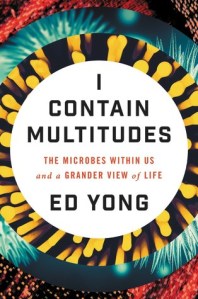
While we tend to chuck microbes into a general “yuck” pile of germs in need of disinfecting, truth is, only a slim minority of species are harmful. The rest are not just beneficial, but essential to the ebb and flow of life on this planet. For instance, how did life evolve into multi-cellular, diverse creatures like birds, bugs, hippos, and humans? Because two kinds of microbes teamed up to make finding food and gene replication more successful. In other words, life as we know it would not exist without these critters.
Yong, Ed. I Contain Multitudes: The Microbes Within Us and a Grander View of Life. New York: Ecco, 2016. Print.
Genre: nonfiction
Summary: Acclaimed science writer, Ed Yong shares the latest research spewing out from studies on the tiniest creatures in the universe. As it turns out, small is by no means insignificant. Microbes—also known as germs—influence everything from global weather, our DNA, and even our choices and thoughts! Get ready for a real invasion of the body snatchers!
(Hint: This book makes for an excellent companion text to John Green’s latest YA knock-out, Turtles All the Way Down!)
Critique: Microbes are multitudinous, both in your body and throughout the planet. Every millimeter of every tooth in your mouth houses an entirely unique population of microbes designed to do something useful in your mouth. Same goes for every millimeter of your gums! Don’t forget your fingers, toes, armpits, and genital regions. But microbial significance goes way beyond teeth and testicles! Animals need the chemical byproducts of microbes—called odors, pheromones, and scents—to communicate, navigate, and survive.
Also, it may interest you to know that the human DNA chain does not contain all the instructions we need to shape our bodies to maturity. We borrow instructions from the DNA of microbes in our environment. In other words, your basic DNA is programmed to provide you with intestines, but it is not programmed with instructions for how those tubes ought to bend and fold in order to fit inside your body. Those directions come from a particular microbe. Plenty of other organisms copy this tactic because it is a smart, efficient way to reliably funnel genes over many generations.
Oh, oh! Budding research suggests that where you decide to live or places you yearn to travel or the foods you crave or the partners you attract may all be the result of your microbes spurring you to go out get new kinds of microbes. This theory has some scary implications; first and foremost, that who you think you are may be an illusion. You are not a single identity, but a composite of trillions—an inner horde of bugs that sometimes choruses in unison.
Yong may not have Rebecca Skloot’s ability to weave live action scenes through hunks of exposition (indeed, he loses as many of these threads as he begins), but his descriptions of complex scientific concepts and microbial functions are so engaging and accessible, the reader won’t actually want those woven scenes getting in the way. The best indicator of how good this book is lies in how I geeked out for weeks after I read it. Cocktail party small talk, trips to a public restroom, inviting friends over for dinner, geshundeiting a sneezing stranger, work meetings, waiting in line at the post office—heck, even this blog post—became one more opportunity to share yet another fascinating tidbit of mind-blowing microbial information.
Komentar